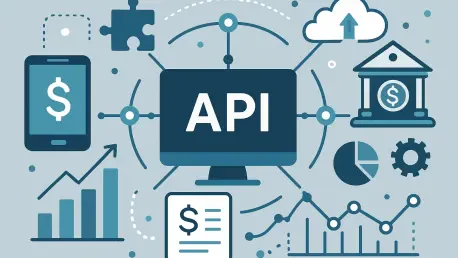In the fast-evolving world of financial services, where digital transformation dictates the pace of competition, a hidden force is shaping the industry’s future, and it lies beneath the sleek interfaces of mobile banking apps and the convenience of instant payments. This force is a complex web of application programming interfaces (APIs) that power these innovations, and their strategic coordination—known as API orchestration—has emerged as a game-changer for banks, fintechs, and other players in the sector. While APIs themselves are not new, this intricate process of harmonizing thousands of APIs to deliver seamless services is redefining how financial institutions operate, innovate, and compete. Far from being a mere technical detail, API orchestration stands as the backbone of modern finance, determining which organizations will lead and which will struggle to keep up in an increasingly digital landscape.
The Transformative Power of API Orchestration
Redefining Connectivity in Financial Services
API orchestration represents a fundamental shift in how financial institutions manage their digital ecosystems, moving beyond simple connectivity to a sophisticated integration of services. APIs, at their core, act as digital bridges that enable interactions such as retrieving account data, processing transactions, or linking with third-party platforms. However, the true value lies in orchestration, which can be compared to a conductor guiding an orchestra to create a unified performance. By coordinating multiple APIs, firms can develop composite products like instant loans or streamlined onboarding processes that combine various data points in real time. This capability allows organizations to not only enhance customer experiences but also accelerate their speed to market, a critical factor in today’s competitive environment. As the scale of API usage grows, with large institutions managing vast ecosystems, the ability to orchestrate these connections effectively becomes a distinguishing feature of industry leaders.
Driving Innovation Through Seamless Integration
The impact of API orchestration extends into the realm of innovation, where it serves as a catalyst for creating new financial products and services. Financial institutions leveraging this technology can consolidate data from disparate sources, offering real-time insights that empower both customers and internal decision-making. For instance, combining APIs from credit scoring systems, payment processors, and customer databases enables the rapid deployment of personalized offerings. This level of integration fosters operational efficiency by reducing redundancies and minimizing delays in service delivery. Moreover, orchestration provides the flexibility to adapt to market demands swiftly, ensuring that firms remain agile amid shifting consumer expectations. As the financial sector continues to embrace digital solutions, those who master this strategic coordination are positioned to outpace competitors, building resilient systems that can withstand disruptions and capitalize on emerging opportunities.
Challenges and Strategic Implications of API Orchestration
Navigating the Risks of API Sprawl and Security
Despite its transformative potential, API orchestration comes with significant challenges that financial institutions must address to fully harness its benefits. One pressing issue is API sprawl, the uncontrolled growth of APIs that often results in management difficulties, poor documentation, and untracked dependencies. This can create security vulnerabilities, as each API endpoint represents a potential target for cyberattacks. A recent report highlighted that a substantial percentage of credential stuffing attacks focus on these endpoints, underscoring the need for robust protective measures. Beyond security, regulatory compliance adds another layer of complexity, as data flowing through multiple APIs must adhere to stringent standards like GDPR and PCI DSS. Failure to manage these risks can lead to inefficiencies, breaches, and costly penalties, making it imperative for organizations to prioritize governance and oversight in their orchestration strategies.
Balancing Autonomy and External Partnerships
The strategic implications of API orchestration reveal a competitive tension within the financial industry, where control over digital ecosystems is at stake. Large banks and fintechs often invest in developing internal orchestration capabilities to maintain autonomy over their innovation pipelines, ensuring they can tailor solutions to their unique needs. In contrast, smaller players frequently turn to specialized API management platforms or Banking-as-a-Service (BaaS) providers for ready-made solutions that reduce the burden of in-house development. This dichotomy between self-reliance and outsourcing reflects broader industry dynamics, where the ability to design and manage API ecosystems as intelligent, dynamic systems often determines success. Vendor lock-in and interoperability issues further complicate this landscape, as reliance on specific providers can limit flexibility and increase costs. Navigating this balance requires a clear vision of long-term goals and a commitment to building adaptable frameworks.
Shaping the Future of Financial Competition
Looking back, the journey of API orchestration in finance reveals both its immense potential and the hurdles that have shaped its adoption. Reflecting on past efforts, institutions that invested in robust orchestration frameworks often gained a competitive edge by launching innovative services ahead of their peers. The challenges of security and sprawl were met with advanced tools and stricter governance, while strategic partnerships helped smaller players level the playing field. As the industry evolved, the focus shifted toward actionable solutions—adopting scalable platforms, prioritizing cybersecurity, and fostering collaboration across ecosystems. Moving forward, financial organizations are encouraged to view orchestration not as a technical necessity but as a core driver of growth. By embracing this mindset, they position themselves to lead the next wave of innovation, ensuring that the invisible engines of APIs continue to power transformative services in an ever-changing digital landscape.









